Studio Visit
In Her Studio by the Sea, Sarah Ball Paints ‘Elusive’ 21st-Century Dandies
The artist's solo show "Tilt" is currently on view at Stephen Friedman Gallery in New York.
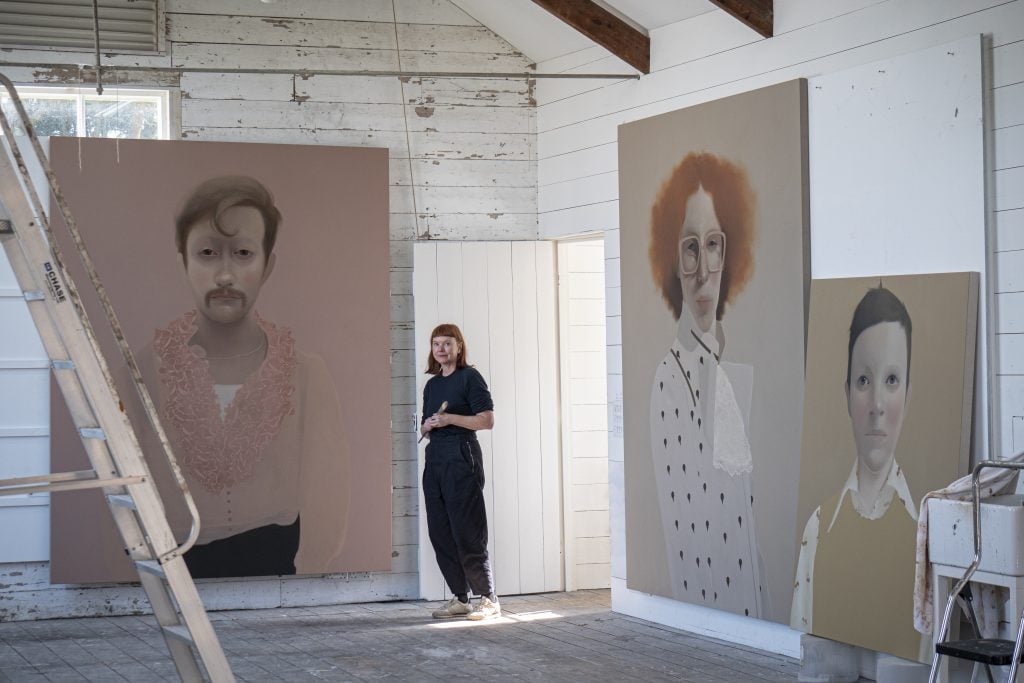
The artist's solo show "Tilt" is currently on view at Stephen Friedman Gallery in New York.

Annikka Olsen

British artist Sarah Ball is recognized for psychologically investigative and meticulously executed portraits, depicting figures that at once seem part of an advanced form of an artistic typology yet ultimately remain wholly unique. Themes of gender, identity, and individualism are examined through a lens of empathy and respect, offering a new way to consider preconceived notions of how we—and others—present to the world within the context of society and culture today.
Deceptively straightforward, Ball’s portraits resist easy reading or understanding, instead seemingly offering themselves as sites of contemplation and reflection—and sometimes even humor.
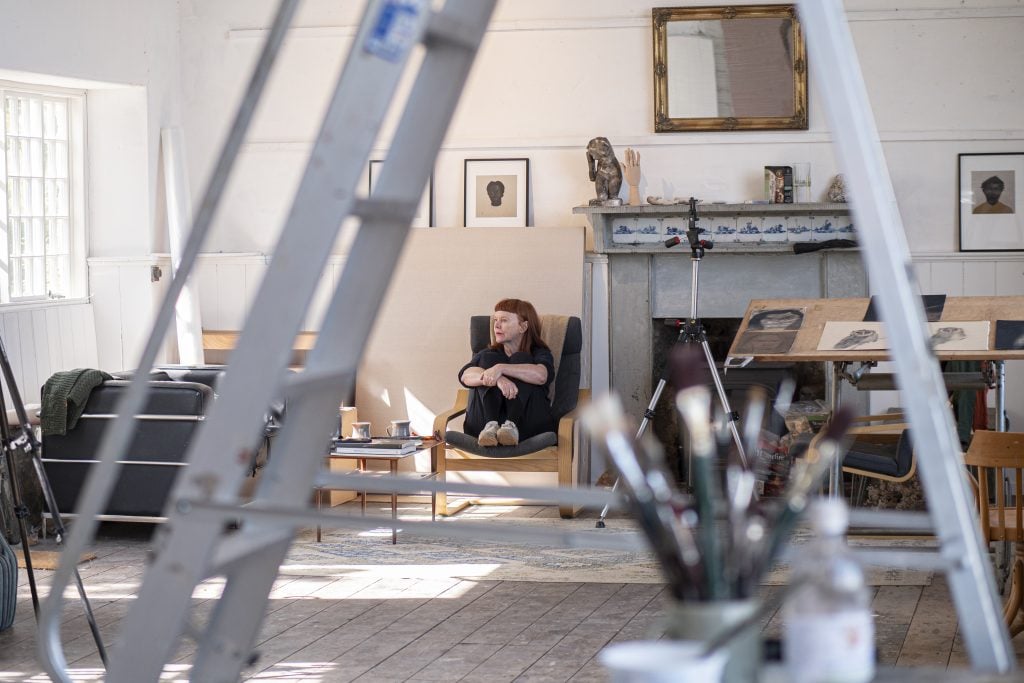
Artist Sarah Ball in her studio. © Alban Roinard. Courtesy of Stephen Friedman Gallery, New York.
Currently, Ball is the subject of her very first solo gallery exhibition in New York, “Sarah Ball: Tilted,” which is on view through March 28, 2024, at Stephen Friedman Gallery; the artist’s work was also previously shown in the city in the gallery’s presentation at Frieze New York in 2021. Using the idea of dandyism within the context of the 21st century as a thematic starting point, Ball explores modes of self-expression and gendered conventions, crafting a visual lexicon based on specific elements of how an individual presents—from facial features and hairstyles to clothing jewelry (and in one work in the show, the holding of a long-haired pet guinea pig). Drawn from a range of sources, including street castings, photographs, and social media, each work conveys Ball’s signature ability to tightly isolate her figures, refusing any allusion to narrative and bestowing a sense of surreal space outside of time.
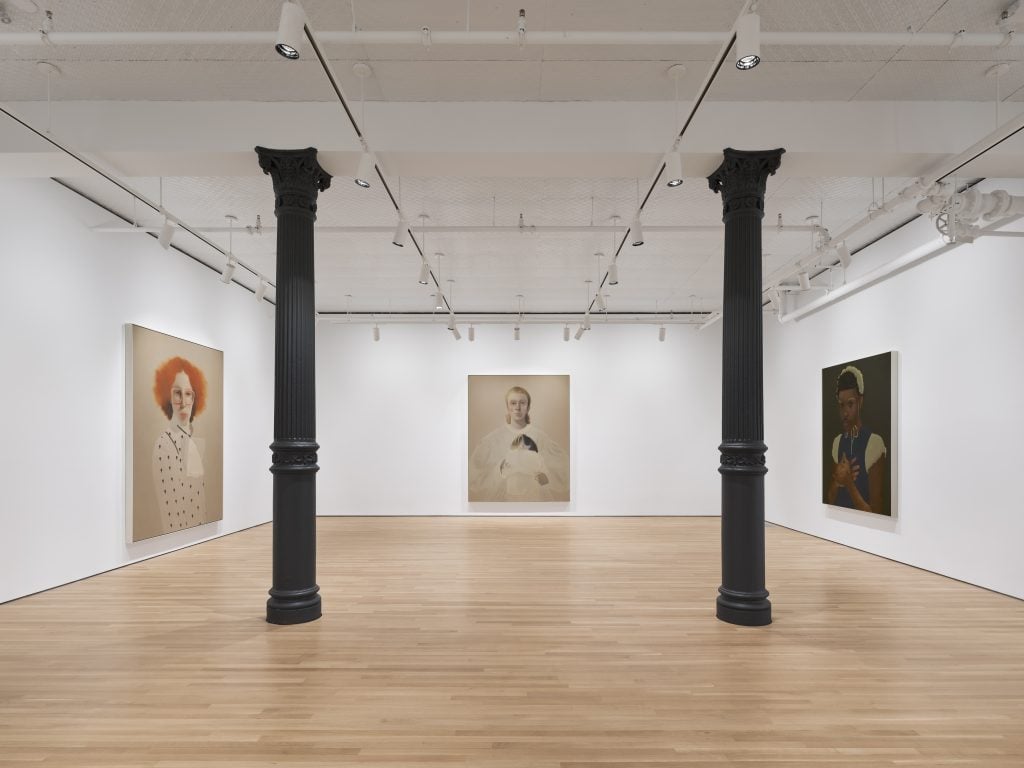
Installation view of “Sarah Ball: Tilted” (2024) at Stephen Friedman Gallery, New York. Photo: Olympia Shannon. Courtesy of Stephen Friedman Gallery, London and New York.
Originally from Yorkshire, Ball is presently based in Cornwall, U.K., where we reach out to her to learn more about the unique studio space she maintains there, and how she develops relationships with the people she bases her figures on.
Can you tell us about your studio? Where is it located, how long have you been there, how would you describe it…?
My studio is located in St Ives, Cornwall—a fishing town in the far southwest of the U.K., with a long association with the arts. The Porthmeor studios were originally built for the local fishing industry. As that industry declined during the 19th century, artists began taking over the building—drawn to St Ives for its extraordinary light. In the first half of the 20th century, Porthmeor became the center of the Modernist movement in British art, hosting influential painters such as Ben Nicholson, Patrick Heron, Sandra Blow, and Francis Bacon. Today artists still share the premises with the fishing industry.
My studio is a wood-paneled room with a wood-burning stove and an enormous, north-facing window overlooking the beach and the sea. It is quite a rustic space and at times sand blows in through gaps around the window, but the light and history make it a very special place to work. The studios have some short-term residencies in association with Tate St Ives but most of the spaces are occupied by artists working and living in the area. My studio was previously occupied by a painter who worked there for over three decades, and I feel very privileged to be working in this incredible space.
How often and how long do you usually spend in the studio? Are there particular days of the week or times of day that you are most productive?
I mostly go to the studio five or six days a week—a hang-over from when my children were small and weeks had to be highly structured. I live two bus journeys away from St Ives, but I’m usually in the studio by 9:30 a.m. and stay there for the whole day, depending on the quality of the light. It’s important for me to be present in the studio, even if I’m not physically painting. I tend to work in intense, highly concentrated bursts of activity that run for months, followed by periods away to recharge, reassess, and then return.
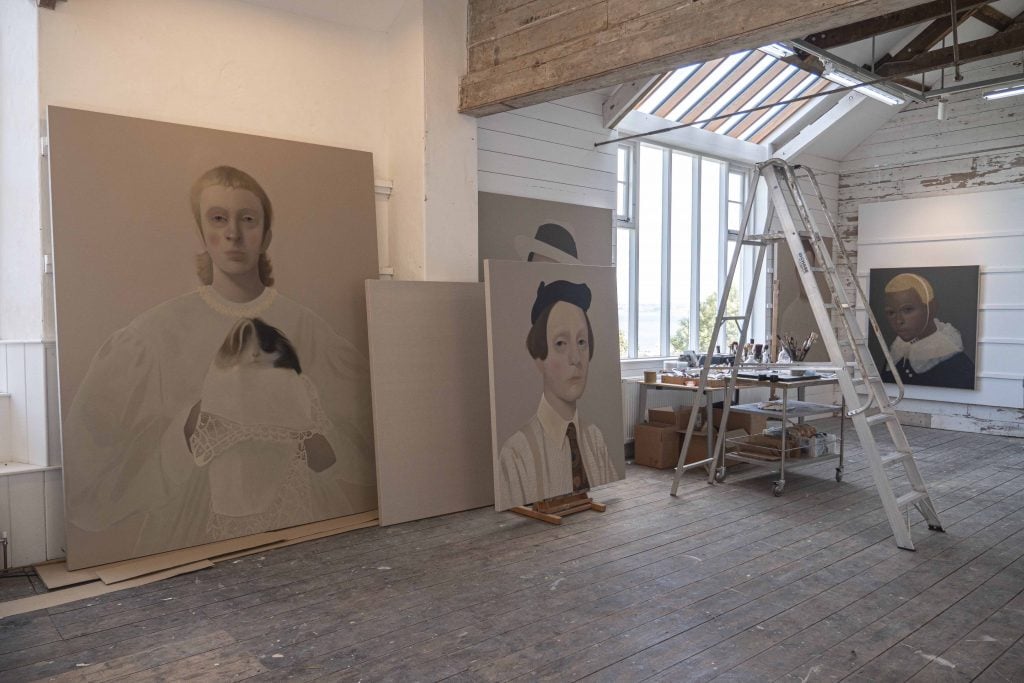
Artist Sarah Ball’s studio. © Alban Roinard. Courtesy of Stephen Friedman Gallery, New York.
What do you like to look at or listen to while you’re working? And does the atmosphere of your studio influence the way you work?
The light makes the studio such an incredible place to work. I usually start the day with music whilst I get the space ready to begin painting. Favorites include Bowie, Christine & The Queens, and the Cure—but it can be classical, such as Mozart, Puccini, or Rachmaninov depending on my mood, the weather, or the day.
I find it hard to work to music as I can find it distracting on an emotional level, but I need to fill the space with voices as I paint—so I tend to listen to the radio, art podcasts, and drama. I sometimes reintroduce music at the end of the day, whilst cleaning brushes, or as I’m actually finishing a painting, as it can bring a distinct and useful energy.
When you feel stuck while preparing for a show, what do you do to get unstuck?
If I feel stuck or feel that the painting isn’t going as well as I’d like, I go for a walk. That’s always my answer—to walk on the beach or around the headland.
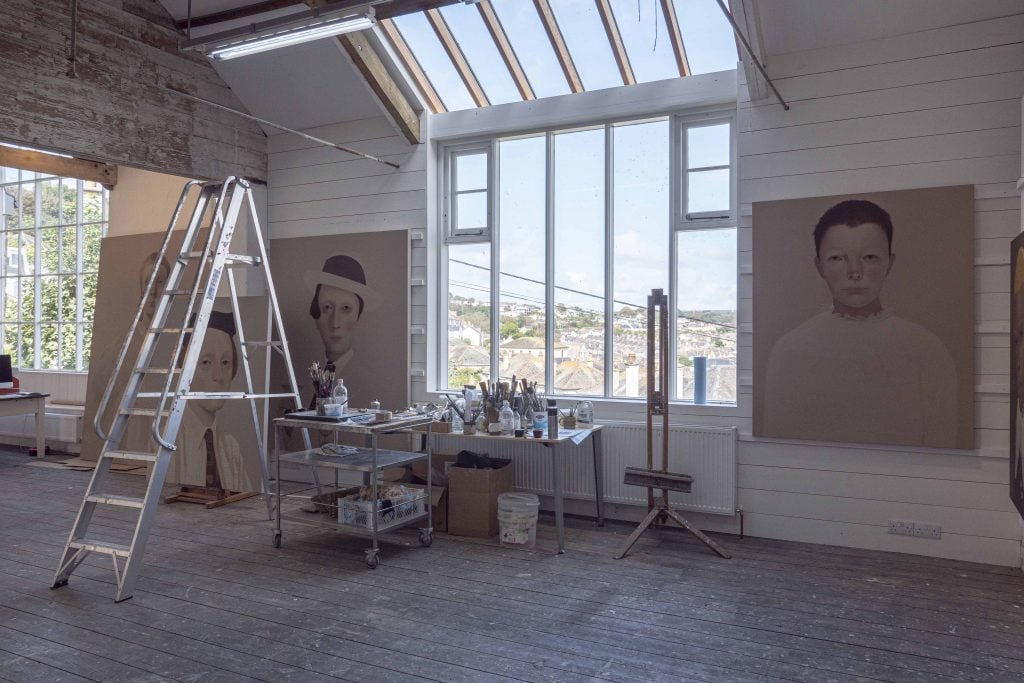
Artist Sarah Ball’s studio. © Alban Roinard. Courtesy of Stephen Friedman Gallery, London and New York.
What is your favorite tool, medium, or other art supply that you love working with most, even if it’s not often? Alternatively, is there anything someone might be surprised to find in your studio?
Brushes and binoculars for whale dolphin watching.
What went into producing the works on view in “Tilted”? How long did a painting typically take? Did you work on one at a time or move between them?
I work from photographs—found or made—and much of my practice is intuitive. I choose people to paint simply by my immediate response to their presence. That could be via a photograph I come across on social media of a person I’ve never met, or through a chance meeting with someone in the street whom I photograph there and then.
If I find an existing image on social media, I will always contact the person and seek their permission—and from those initial conversations or chance street meetings, deeper connections grow. Some sitters, such as the two Elliots in the exhibition, I return to and have painted numerous times, charting their evolving, contemporary selves. Others in this exhibition are new to me, people I have never met in person, but through the act of making the work, I have developed a relationship with them.
A painting can take anywhere between six weeks to a few months, once I have found and contacted the subject. I often work on between one and three pieces at a time because of the way I layer paint. It is often essential to put a painting to one side to dry, and I’ll work on the others during this time. This show has taken me nearly two years to complete.
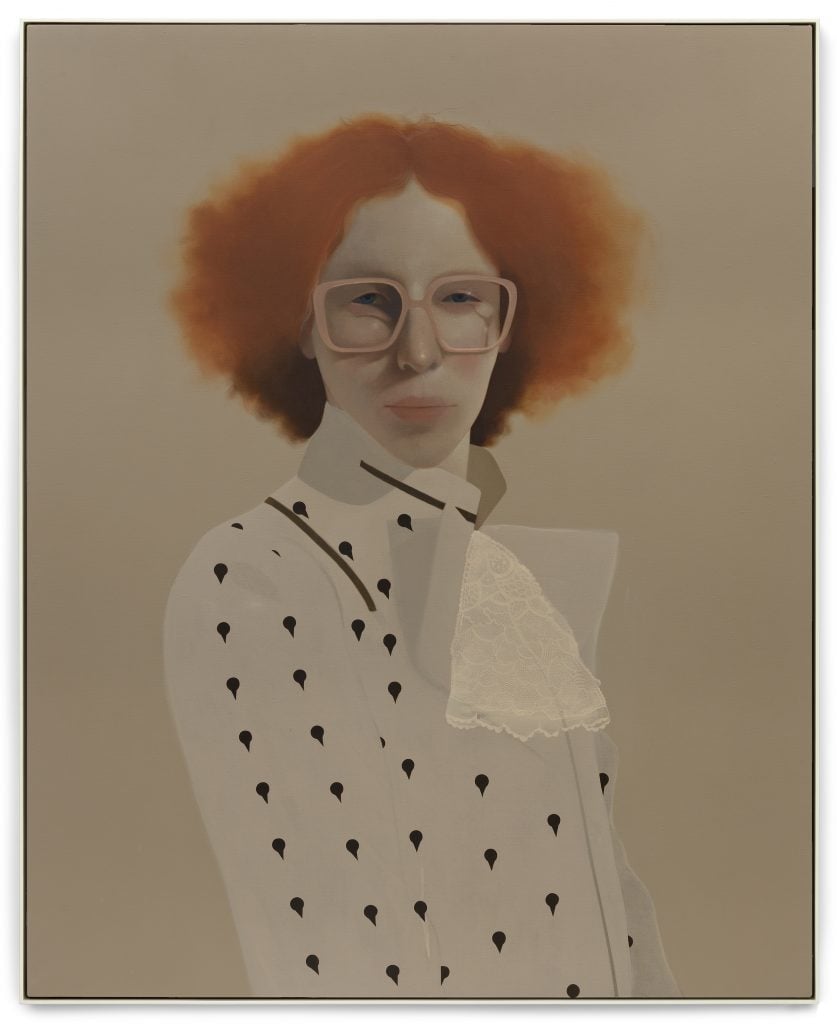
Sarah Ball, Elliot (2023). © Sarah Ball. Photo: Todd White Art Photography. Courtesy of the artist and Stephen Friedman Gallery, London and New York.
As the show is inspired by dandyism in the 21st century, what sort of materials, images, or sources of inspiration or reference did you keep on hand? Do you work from live models or photos?
The idea of the ‘Dandy’ forms part of a much wider conversation about the subject of identity and how we define ourselves—how we manifest and engage (or not) with our changing personalities and evolving identities.
While working towards the show, I often referred to an essay by Andrew Solomon in which he examines the idea of the Dandy throughout history. The essay was written before Instagram and so the exhibition might be seen as an appendix to that text—asking visual questions about the form of the Dandy in our over-sharing society.
Ideas shift and this exhibition isn’t a definitive statement—the Dandy remains elusive. Susan Sontag, writing in the late 20th century, thought that the Dandy, in an era of mass consumerism, could be found in camp. For me, the people I have painted are individuals who exhibit a very personal, theatrical, and creative path in the way they present themselves. I want to celebrate that.
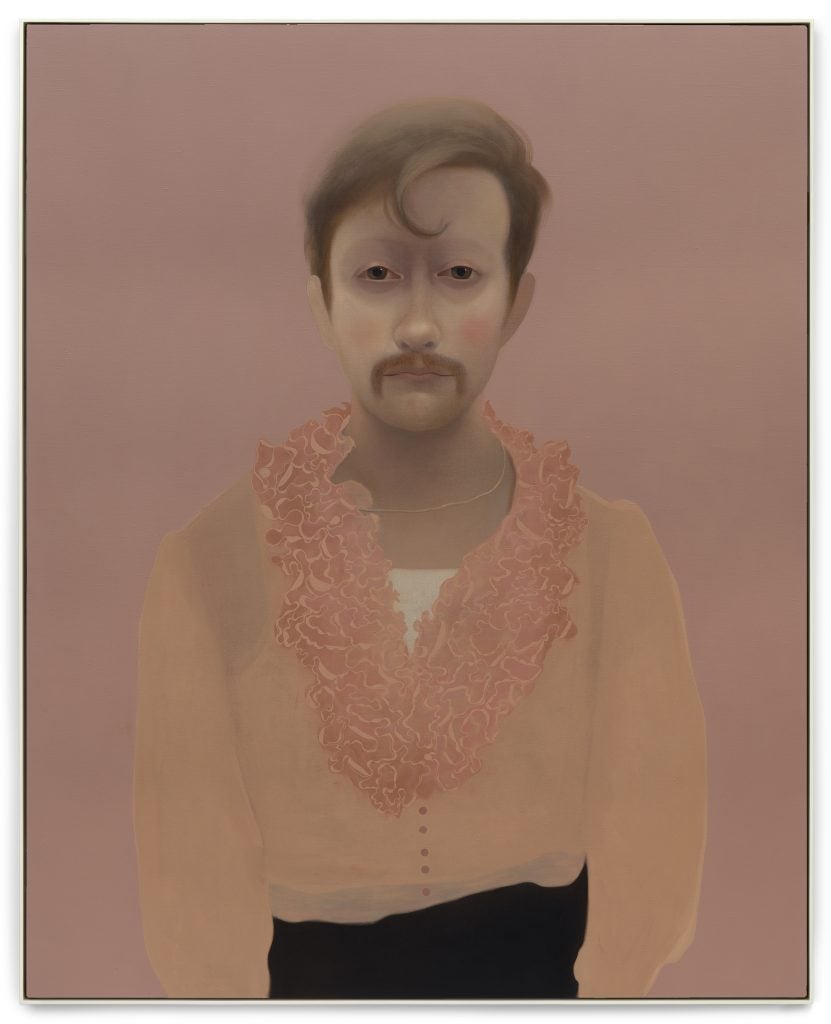
Sarah Ball, Pink Elliot (2023). © Sarah Ball. Photo: Todd-White Art Photography. Courtesy of the artist and Stephen Friedman Gallery, London and New York.
Key influences always for my work are Flemish painting from the 1400s onwards, and English Tudor and Elizabethan portraits. I also look to cinema—filmmakers like Roy Andersson and Jacques Tati—storytellers who cut everything but the essential from the cinematic frame, but who are able to add layers of ambiguity and mystery.
Two paintings in particular were a constant “go to” while making this body of work—both of which were included in the “Fashioning Masculinity” exhibition at the Victoria and Albert Museum in London. One is a painting of Prince Alessandro Farnese by Sofonisba Anguissola, made in 1560, in which the prince is portrayed in short cape and tight hose, with elaborate embroidery that’s exquisitely rendered by the painter. The other work, made in 1664, is by Jacob Huymans, a painting of Frances Stewart who was to become Duchess of Richmond. In it, the subject is depicted in a soldier’s buff coat with her hand fondling the hilt of her sword. The painting captures the fashion for English women of the time to wear masculine riding clothes.
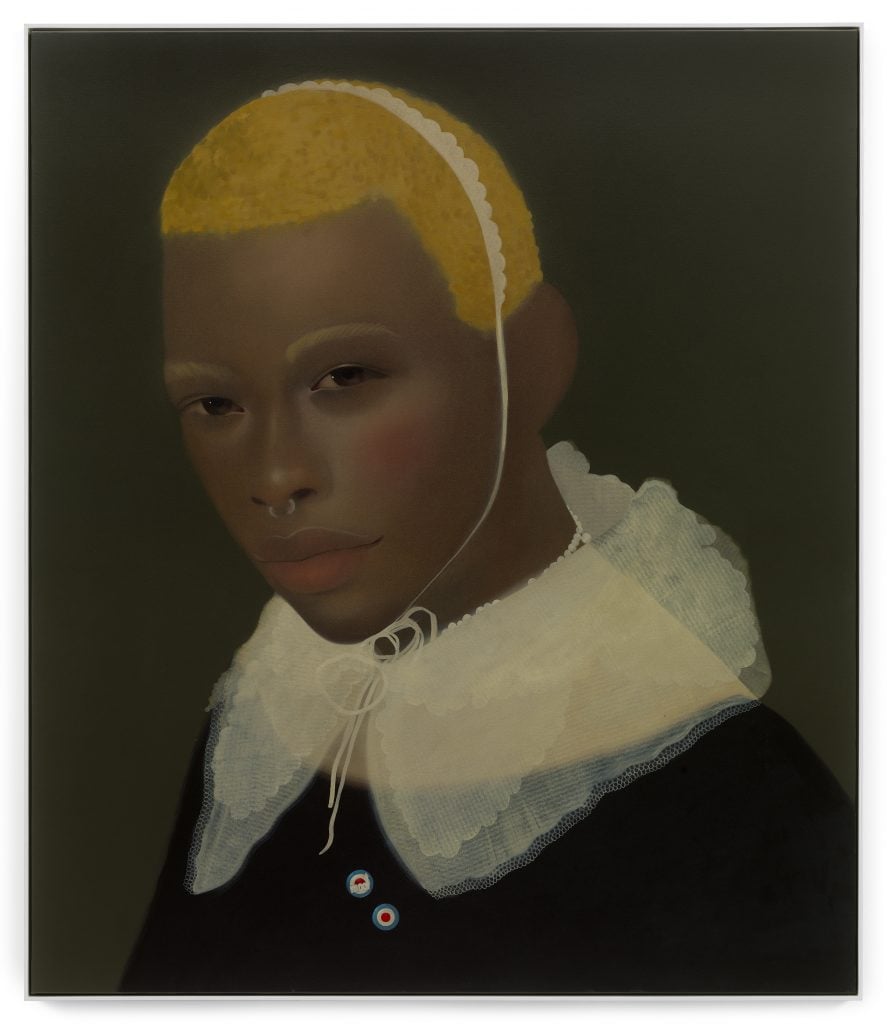
Sarah ball, Von (2023). © Sarah Ball. Photo: Todd-White Art Photography. Courtesy of the artist and Stephen Friedman Gallery, London and New York.
Can you talk about what you are working on right now?
I have just completed a painting which will be included in a group exhibition curated by Alona Pardo entitled “The Infinite Woman,” opening at the end of April at Fondation Carmignac in the South of France.
I am just about to begin work on a solo exhibition to be held at Longlati Foundation in Shanghai, China, which opens in October 2025.
“Sarah Ball: Tilted” is on view at Stephen Friedman Gallery, New York, through March 23, 2024.
